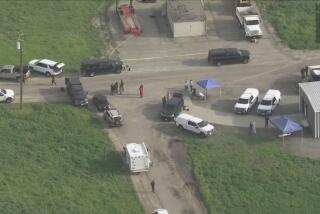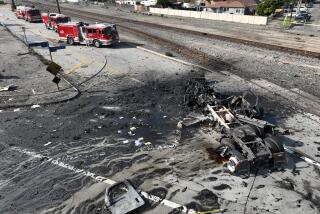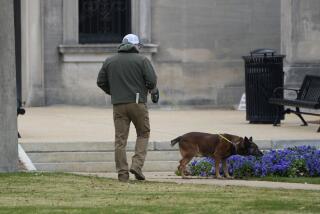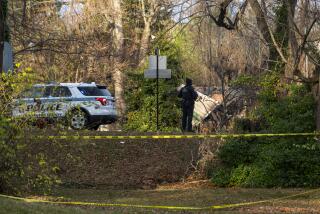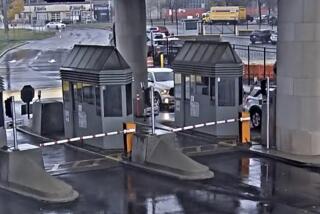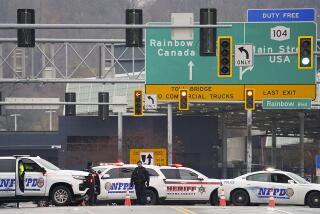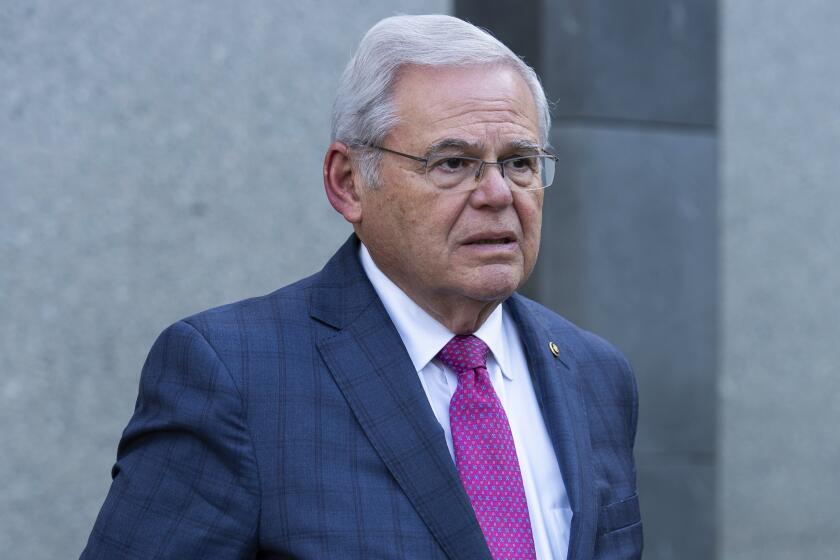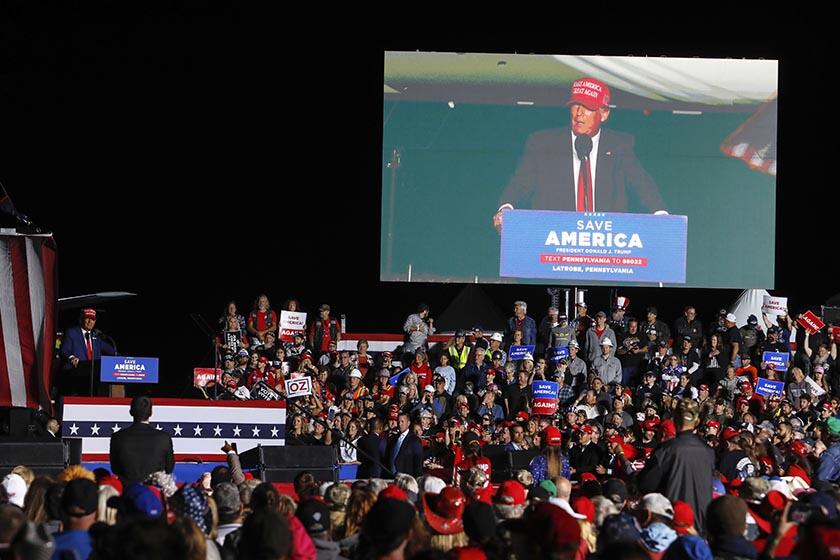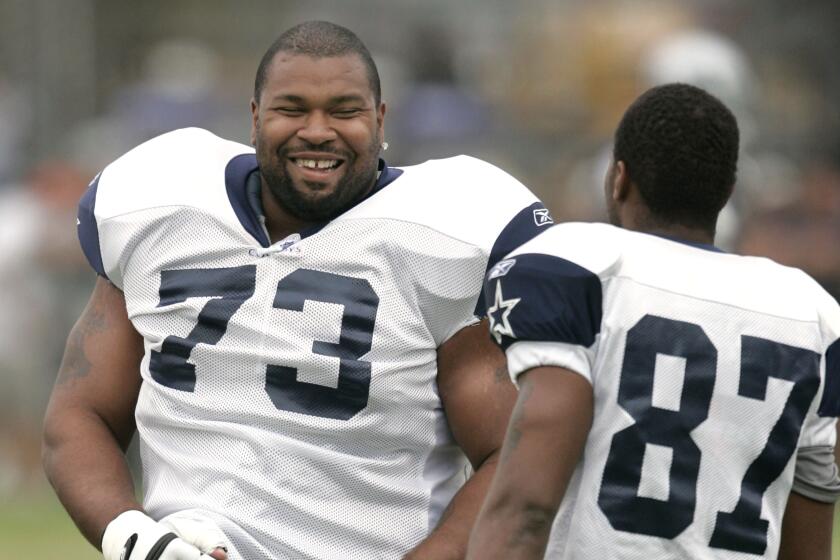FBI Believes Video Shows Bomb Truck
As federal authorities pressed their investigation of the worst terrorist attack in U.S. history, the senior FBI agent spearheading the inquiry said Monday that the government had obtained a videotape, shot near the Alfred P. Murrah Federal Building, that investigators believe shows the truck used to carry the deadly bomb.
The vehicle, a 1993 Ford truck obtained from a Ryder rental franchise in Junction City, Kan., is believed to have delivered 1,000 to 1,200 pounds of a volatile mixture of fuel oil and ammonium nitrate, a fertilizer, to a spot near the front entrance of the nine-story office building shortly before the blast at 9:04 a.m. last Wednesday.
The disclosure of the videotape represented perhaps the most encouraging step in the painstaking process of piecing together fragments of evidence and it came as agents continued their frustrating search for a second suspect, the so-called “John Doe No. 2,” who is believed to have rented the van.
One suspect, Timothy McVeigh, 27, a former soldier who has been linked by federal authorities to paramilitary activities and anti-government causes, was arrested Friday, two days after the explosion, and has been charged in the capital case.
Although authorities are pressing a nationwide search for the second man, the failure to find him after five days and thousands of leads has begun to stir both frustration and apprehension among investigators.
Is Suspect Dead?
Weldon Kennedy, the senior FBI agent in charge of the investigation in Oklahoma City, said for the first time Monday that John Doe No. 2 could lie dead in the rubble of the federal building, killed when the bomb exploded in the truck.
“We could not be able to determine that with certainty until we have all the forensic evidence that we will obtain from the site itself,” Kennedy said. But another source close to the investigation voiced what to investigators would be a more unsettling concern: If the second figure died at the scene, “they won’t find him. He could very well be dead already and how do you find somebody who was blown into a million pieces?”--especially when his identity was a mystery to begin with.
A second concern, the source added, is that the suspect, if alive, has more and more time to go into hiding as times passes. And he could force police into a potentially deadly confrontation when he is found.
“Remember, these guys are survivalists,” he said. “Soon enough he (would be) be hiding somewhere in the mountains of Idaho.”
As they sifted the evidence at the bomb scene, investigators were also trying to determine whether shards of blue plastic found there came from the same kind of plastic drums seized at the Kansas home of a man being held as a material witness in the case, a source close to the case said.
Analysis of the material was underway and investigators have not yet drawn conclusions, he said.
The drums were seized at the home of Terry Lynn Nichols in Herington, Kan. He and his brother, James Douglas Nichols of Decker, Mich., are being held in custody as material witnesses. McVeigh served in the Army with Terry Nichols, and lived recently at James Nichols’ farmhouse in Decker.
McVeigh, meanwhile, was described by the lawyer assigned to his case as courteous and polite. However, the lawyer said, his client--being held in the El Reno Correctional facility near Oklahoma City--has declined to speak with federal agents.
Other Developments
In other developments Monday:
* Federal sources backed away from earlier statements that Terry Nichols is likely to be charged with firearms violations after a two-day search of his Kansas house turned up material that would be illegal for him to possess. Further testing of material uncovered during the search is necessary, one source said.
James Nichols is scheduled to be taken to a hearing today near Detroit on whether he should be taken to Oklahoma City as a material witness. Terry Nichols is scheduled to have a similar hearing in Kansas on Wednesday. He faces possible charges for constructing explosive devices.
* Federal authorities, it was learned, are interested in the disappearance of a number of blasting caps during the last year from a rock quarry in Marion County, Kan. Terry Nichols was said to have worked in the county not far from Herington.
* More than 100 people worked through the night trying to identify the remains of the explosion’s victims. Medical specialists and FBI fingerprint experts anticipate problems as the rubble yields more victims. “Anything that will tear up a building like that will certainly tear up humans. We certainly are faced with the problem of fragmenting bodies,” said Ray Blakeney, director of operations for the Oklahoma state medical examiner’s office.
* Funeral services were conducted for the first victims recovered from the site, including some of the toddlers and babies killed in a day-care center on the second floor. Baylee Almon, the 1-year-old who was pictured in the arms of a firefighter as he rushed her out of the wreckage, was buried in a tiny white coffin covered with pink carnations, white daisies and a pink ribbon that read “Miss Baylee.”
* The federal Centers for Disease Control and Prevention dispatched a five-member team Monday to Oklahoma City to analyze the nature and type of injuries suffered both by survivors and those who were killed in the blast. Spokesman Bob Howard said that such information can help determine “what can be done in the future to prevent these kinds of injuries.”
* Senate leaders said they would give quick consideration to President Clinton’s proposals, as well as to other proposals already before Congress, to strengthen the government’s anti-terrorism campaign. Clinton said Sunday night that he would seek expanded powers to examine telephone, credit card and hotel records to track terrorist activities.
Public Asked to Help
The discovery of the videotape, taken by a private security camera in the downtown area, prompted authorities once more to ask for assistance from the public and to issue what they called “a special appeal” to local business owners for any other videotapes, shot by surveillance cameras, that also might show the truck, its driver and any passengers.
“The lab investigators looked at that tape and believe that it shows and depicts the Ryder truck,” Kennedy said.
Trying to track the origin of the fertilizer used in the bomb, FBI agents have questioned the owner of one of the largest agricultural chemical stores near Junction City, who said that his company sold 3,000 pounds of ammonium nitrate, in 60 50-pound bags last February.
The businessman, Joe Hund, owner of Geary Grain, told The Times that he was questioned by FBI agents and agents of the Army investigations office at nearby Ft. Riley, about the transaction, his only sale of the chemical this year.
Hund said it took place in February and was made to people who appeared to be military personnel who said they wanted it to fertilize lawns at the base.
An investigator, expressing skepticism about the purported use, said: “That’s a helluva lot of green lawn,” according to Hund.
Another merchant, Jim Otte, part owner of Sunflower Service in Herington, said Monday that he, too, had received recent requests for large bags of such lawn fertilizer.
At the site of the blast, rescuers, who have been forced to pick through the rubble slowly for fear of provoking a collapse of the precarious wreckage, retrieved the body of a U.S. Marine, who was buried in the rubble as he sat at his desk.
White House Chief of Staff Leon E. Panetta, speaking at the annual meeting of the Associated Press in New Orleans, said that it is possible the death toll might exceed 200, a figure based on the recovery of 83 bodies and the expectation that 150 to 160 people are still missing and presumed to be “still within the building.”
Lawyers Want Out
Meanwhile, two lawyers appointed by the federal court to represent McVeigh asked a federal magistrate if they could withdraw from the case, saying that they believe they could not do the job fairly. One of them, John W. Coyle III, a criminal defense attorney, said that he and Susan Otto, a federal public defender, have friends who died in the blast. Coyle said that he fears for his safety and that of his family.
He said that he has received death threats because of his representation of McVeigh and that he is receiving round-the-clock protection.
“I don’t see how any lawyers in Oklahoma could fairly and objectively handle the case,” he said, asking that the trial be moved from the state.
“We have fair judges. We have fair jurors. But this is too much to ask of any grand juror or any trial juror to try to be fair in a case like this. This has touched the life of every person in our community,” Coyle said.
As the investigation proceeded, much of it invisible to outsiders, authorities pored over leads that have mushroomed into the thousands. Of 9,000 tips, 6,200 are being taken seriously enough to warrant follow-up investigation.
“This case continues to be very active,” said the FBI’s Kennedy. “We are very confident that this progress will continue to move toward the successful prosecution and punishment of those responsible.” Meanwhile, sketches of McVeigh’s recent activities, as well as questions about how he has spent recent months, continued to surface, as have some details of his recent days in jail.
Attorney Coyle described McVeigh as courteous in the two visits he has had with him. “He’s been very polite with us,” Coyle said. “He’s been most polite with us.”
The lawyer also said that McVeigh has given no interviews to federal agents. But, he added, “there’s not a refusal to cooperate.”
“Every citizen is entitled not to talk to someone if they don’t want to.”
However, another source close to the case drew a starkly different picture of McVeigh, who is being held in a solitary cell.
“He is like a cold fish, calm and collected,” said the source, who asked not to be identified. “Some of the people in the system dealing with him say he is the scariest man they have ever seen. He sees himself as a soldier,” the source added.
Earlier Bombing
Kennedy said that authorities are continuing to investigate McVeigh’s “movements and activities before the bomb blast.” He added that “we are vigorously pursuing” whether McVeigh was present during an earlier bombing in Kingman, Ariz., where the suspect is believed to have spent much of the last two years.
He was described there as a young man who often wore combat boots and was unfailingly polite to people around him.
“He kept to himself,” said Lynda Willoughby, who rented McVeigh a mailbox at her small store, the Mail Room. “He was quiet and well-mannered.”
That same description came from Paul Shuffler, who hired him as a dock loader at his Tru Valu Hardware Store from February through April, 1994. And Walter Mack McCarty, who said he taught McVeigh in a handgun self-defense class, found it hard to imagine that he would bomb the Oklahoma City federal building.
“He seemed like a kid I could really like,” McCarty said.
Willoughby said that McVeigh has rented a mailbox since May, 1993, and that he picked up his mail regularly. Although she had seen him less frequently recently, she said, he had been showing up as late as early April. Occasionally, she said, someone else would arrive to retrieve McVeigh’s mail.
Willoughby said that FBI agents seized all of McVeigh’s mail, including a number of unmarked envelopes and birthday cards, on Sunday night. Sunday was McVeigh’s 27th birthday.
Shown a picture of John Doe No. 2 by federal agents, Willoughby said she recognized the person as someone she had seen in the Kingman area.
McVeigh apparently lived with a man named Michael Fortier, who also worked at the hardware store last year. Fortier refused to comment.
At his hearing in Michigan on Wednesday, James Nichols will be represented by a public defender. In a financial affidavit he filed Saturday to support his request for such assistance, he wrote that he earns $12,000 a year as a self-employed farmer and described his assets as property valued at $2,000, a $500 1976 Ford pickup truck, a $5,000 1978 Chevy stake truck and another stake truck worth $4,000.
Serrano reported from Oklahoma City and Ostrow from Washington. Times staff writers Louis Sahagun in Junction City, Kan., Tina Daunt in Kingman, Ariz., J. Michael Kennedy in Los Angeles, Judy Pasternak in Michigan and James Gerstenzang in Washington contributed to this story.
More to Read
More to Read
More to Read
Start your day right
Sign up for Essential California for news, features and recommendations from the L.A. Times and beyond in your inbox six days a week.
You may occasionally receive promotional content from the Los Angeles Times.

